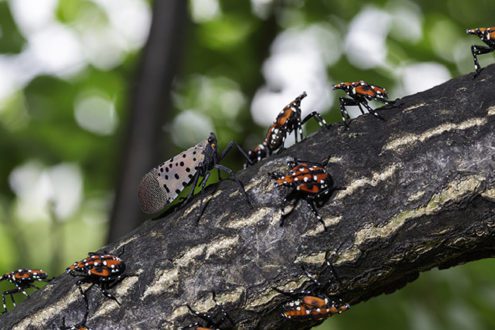Sep 16, 2020ARS scientists seek answers from spotted lanternfly dispersal
The black spots and beautiful colors can be deceiving.
At first glance, the spotted lanternfly (Lycorma delicatula) is a beautiful insect whose colors mimic the beloved ladybug with its polka-dotted outer wings and red hind wing. But this is not the family-friendly insect that people love to see crawling on their wrist or captured in a framed print in a powder room.
The spotted lanternfly is an invasive species that destroy fruit crops, trees and plants by hopping from plant to plant, crop to crop, and tree to tree. Although native to regions in China, India, and Vietnam, it was first detected in Berks County, Pennsylvania in 2014. Since then, Pennsylvania vineyards have seen considerable damage in high infestation areas and the Mid-Atlantic states of Delaware, Maryland, New Jersey, Virginia and West Virginia have also suffered from its presence. Insecticides are effective at killing the insect on grapevines, but they are expensive and of limited use because of constant re-infestation from the spotted lanternfly dispersing from wild hosts to surrounding vineyards.
The good thing is that the spotted lanternfly isn’t known to bite or sting – but they are known to ruin an agricultural harvest. So, U.S. Department of Agriculture Scientists Tracy Leskey and Laura Nixon of the Appalachian Fruit Research Station in Kearneysville, West Virginia, initiated research on the invasive pest to see if they could develop sustainable pest management strategies and use the insect’s dispersal patterns for other prolific specialty crop pests.
Leskey and Nixon collected spotted lanternfly nymphs and adults from host plants in sites within a quarantine zone in Virginia. They then measured the pest’s vertical climbing and horizontal jumping capacity and evaluated the effect of fluorescent marking powders on the nymph and adult’s mobility and ability to survive. Each color of powder (green, blue, orange, and pink) was tested at least twice per host plant. When the presence of fluorescent powder wasn’t visible, a UV flashlight was shone onto a nymph to confirm fluorescence. To establish baseline vertical walking and horizontal jumping dispersal capacity, Leskey and Nixon also evaluated all mobile life stages using bioassays conducted under field conditions in the quarantine zone.
The findings were surprising. Spotted lanternfly nymphs climbed significantly longer vertical distances compared with adults, while early adults (pre-oviposition period) jumped longer horizontal distances compared with nymphs or late adults (oviposition period) based on single jump measurements. The research also showed that marking nymphs and adults with fluorescent powder has no significant effect on vertical or horizontal movement and did not affect their mortality. Rather, research showed that the pest can be marked with fluorescent powders and retrieved from potted host plants within 24 hours. This means that marking the spotted lanternfly with fluorescent powder can serve as an appropriate method for measuring their dispersal in the environment. This can ultimately help researchers understand the spotted lanternfly’s migration pattern and find a way to prevent future movement and destruction.
Leskey and Nixon are currently working to continue their research of spotted lanternfly dispersal behavior so they can continue to deliver scientific solutions to national and global agricultural challenges.
The Agricultural Research Service is the U.S. Department of Agriculture’s chief scientific in-house research agency.
– Autumn Canaday, ARS USDA
Spotted lanternfly (Lycorma delicatula) winged adult; 4th instar nymph (red body). Photo: Stephen Ausmus















